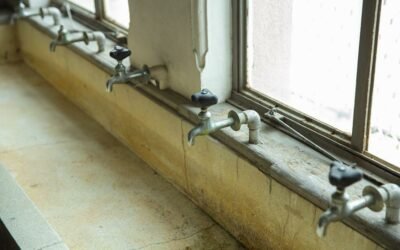If you're battling mold and wondering if hypochlorous acid can be the solution, this article has the answers you seek. Learn about the science behind hypochlorous acid's mold-killing abilities and discover the pros and cons of using it for mold remediation.
We'll also guide you on how to safely utilize hypochlorous acid to effectively eliminate mold. Get ready to tackle your mold problem head-on with this informative and technical exploration of hypochlorous acid's potential.
Key Takeaways
- Hypochlorous acid is a highly effective disinfectant that can kill mold.
- It breaks down the proteins and enzymes in mold, effectively killing it.
- Hypochlorous acid is safe for use on a wide range of surfaces and is non-toxic and non-irritating.
- Mold can cause allergic reactions, respiratory problems, and infections.
What Is Hypochlorous Acid
Hypochlorous acid is a highly effective disinfectant that you can use to kill mold. It's a chemical compound with the formula HOCl and is produced naturally by the human body's immune system to fight off pathogens. Hypochlorous acid is also commonly found in bleach and other cleaning products.
This powerful disinfectant works by breaking down the proteins and enzymes that make up mold, effectively killing it. When hypochlorous acid comes into contact with mold, it reacts with the cell walls, disrupting their structure and causing them to break down. This leads to the destruction of the mold and prevents it from spreading further.
One of the key advantages of using hypochlorous acid to kill mold is that it's safe for use on a wide range of surfaces. Unlike some other disinfectants, hypochlorous acid doesn't leave behind any harmful residue or fumes. It's non-toxic and non-irritating, making it suitable for use in both residential and commercial settings.
To use hypochlorous acid to kill mold, simply spray or wipe the affected area with a solution containing the acid. Allow it to sit for a few minutes to ensure thorough coverage and then rinse or wipe away the residue. Remember to always follow the manufacturer's instructions and wear protective gloves and eyewear when working with hypochlorous acid.
Understanding Mold Growth and Health Risks
After understanding how hypochlorous acid effectively kills mold, it's important for you to be aware of the potential health risks associated with mold growth.
- Mold can cause various health issues, including allergic reactions, respiratory problems, and infections.
- Exposure to mold spores can trigger allergic reactions in sensitive individuals, leading to symptoms such as sneezing, coughing, and skin rashes.
- Mold can also worsen respiratory conditions such as asthma, causing wheezing, shortness of breath, and chest tightness.
- Certain molds produce mycotoxins, which are toxic substances that can cause more severe health effects, including neurological problems and immune system disorders.
- Prolonged exposure to mold can lead to chronic sinus infections, bronchitis, and other respiratory infections.
People with weakened immune systems, such as those with HIV/AIDS or undergoing chemotherapy, are at a higher risk of developing serious mold-related infections. The elderly, young children, and individuals with pre-existing respiratory conditions are also more susceptible to mold-related health issues.
To protect yourself and your loved ones from these health risks, it's crucial to prevent and eliminate mold growth in your living environment. Regular cleaning, proper ventilation, and moisture control are key in preventing mold growth and reducing the associated health hazards.
The Science Behind Hypochlorous Acid's Mold-Killing Abilities
To understand how hypochlorous acid effectively kills mold, let's delve into its molecular level workings.
Hypochlorous acid is a powerful oxidizing agent that acts by disrupting the cellular processes of mold. When hypochlorous acid comes into contact with mold spores or hyphae, it quickly penetrates their cell walls.
Once inside the mold cells, hypochlorous acid reacts with various cellular components, such as proteins and enzymes, leading to their denaturation or inactivation. This disruption of essential cellular processes ultimately results in the death of the mold.
Hypochlorous acid's ability to kill mold is primarily due to its strong oxidative properties. It can break down the structural components of mold cells, including lipids, proteins, and nucleic acids, through oxidation reactions. These reactions generate reactive oxygen species (ROS), which are highly reactive molecules that can cause severe damage to cellular structures and biomolecules.
Furthermore, hypochlorous acid can also disrupt the osmotic balance within mold cells. By increasing the osmotic pressure inside the cells, hypochlorous acid leads to cellular dehydration and collapse, further contributing to mold cell death.
Pros and Cons of Using Hypochlorous Acid on Mold
Using hypochlorous acid on mold has both advantages and disadvantages. Here are some key points to consider:
- Advantages:
- Effective mold removal: Hypochlorous acid is proven to be highly effective in killing and removing mold. It can penetrate porous surfaces and kill mold at its roots, preventing regrowth.
- Broad spectrum antimicrobial properties: Hypochlorous acid not only kills mold but also eliminates other harmful microorganisms such as bacteria and viruses. This makes it an excellent choice for overall disinfection.
- Safe for use: Unlike harsh chemicals, hypochlorous acid is non-toxic and safe for humans, pets, and the environment. It doesn't produce toxic fumes or leave behind harmful residues, making it ideal for use in homes and sensitive areas.
- Disadvantages:
- Limited residual effect: While hypochlorous acid effectively kills mold upon contact, its residual effect is limited. Once the solution dries, it loses its potency, making future mold growth possible.
- Potential material damage: Hypochlorous acid, when used in high concentrations or improperly, can cause damage to certain materials such as fabrics, carpets, and metals. It's essential to follow manufacturer instructions and perform a spot test before applying it.
- Short shelf life: Hypochlorous acid has a relatively short shelf life compared to other disinfectants. It can lose its effectiveness over time, especially when exposed to heat and sunlight. Proper storage and regular replacement are necessary to ensure its efficacy.
Consider these pros and cons when deciding whether to use hypochlorous acid on mold.
How to Safely Use Hypochlorous Acid for Mold Remediation
To safely use hypochlorous acid for mold remediation, you should follow these guidelines.
First, ensure proper ventilation by opening windows and using fans to circulate the air. This will prevent the buildup of harmful fumes.
Next, wear protective gear such as gloves, goggles, and a respirator mask to avoid direct contact with the acid and minimize inhalation of any vapors.
Before applying the acid, it's important to clean the affected area thoroughly to remove any visible mold.
Once cleaned, mix the hypochlorous acid solution according to the manufacturer's instructions, usually by diluting it with water.
Apply the solution using a spray bottle or a fogging machine, ensuring complete coverage of the affected area.
Allow the solution to sit for the recommended contact time, typically 10-15 minutes, to ensure effective mold elimination.
After the contact time has elapsed, use a clean cloth or sponge to wipe away any residue or remaining mold.
Finally, dispose of any contaminated materials properly and clean all equipment used in the remediation process.
Conclusion
In conclusion, hypochlorous acid has proven to be effective in killing mold due to its strong antimicrobial properties. It works by breaking down the cell walls of mold spores, preventing their growth and multiplication.
While hypochlorous acid is a powerful mold-killing agent, it's important to use it safely and follow proper guidelines for mold remediation. It's always recommended to consult a professional for thorough mold removal and to ensure a safe and healthy environment.






0 Comments